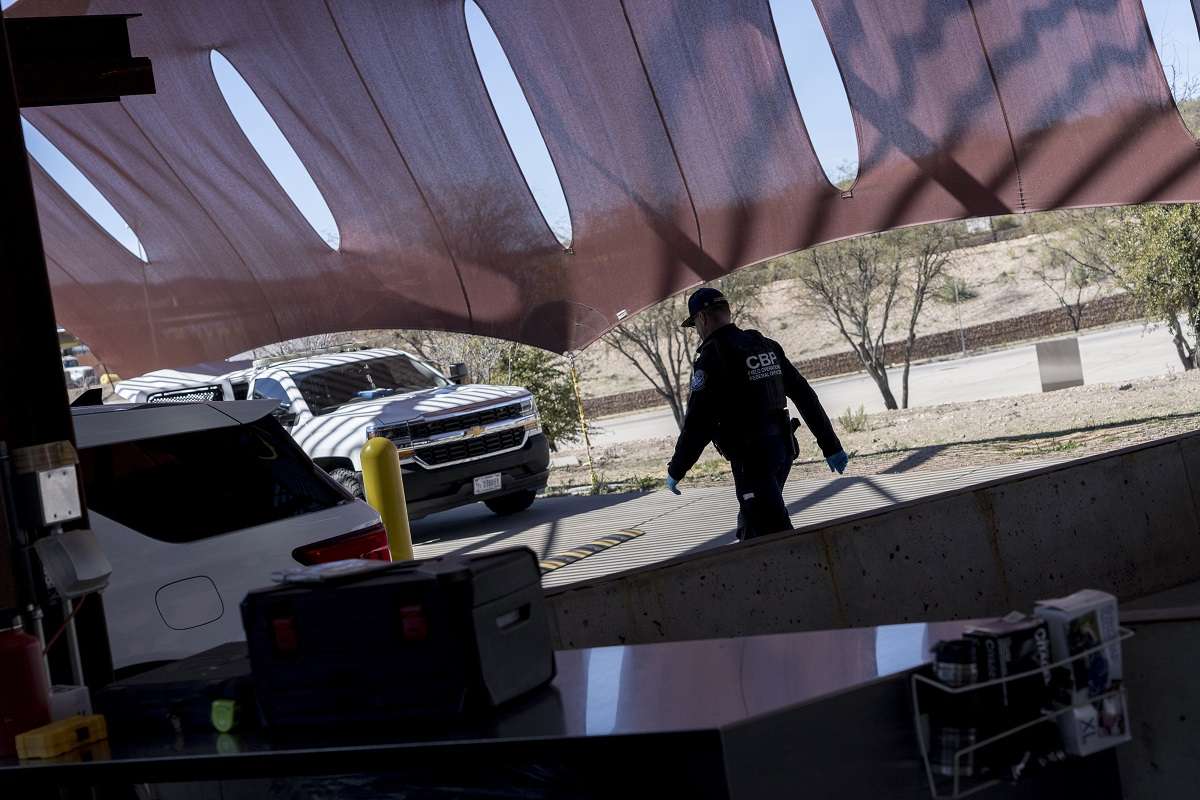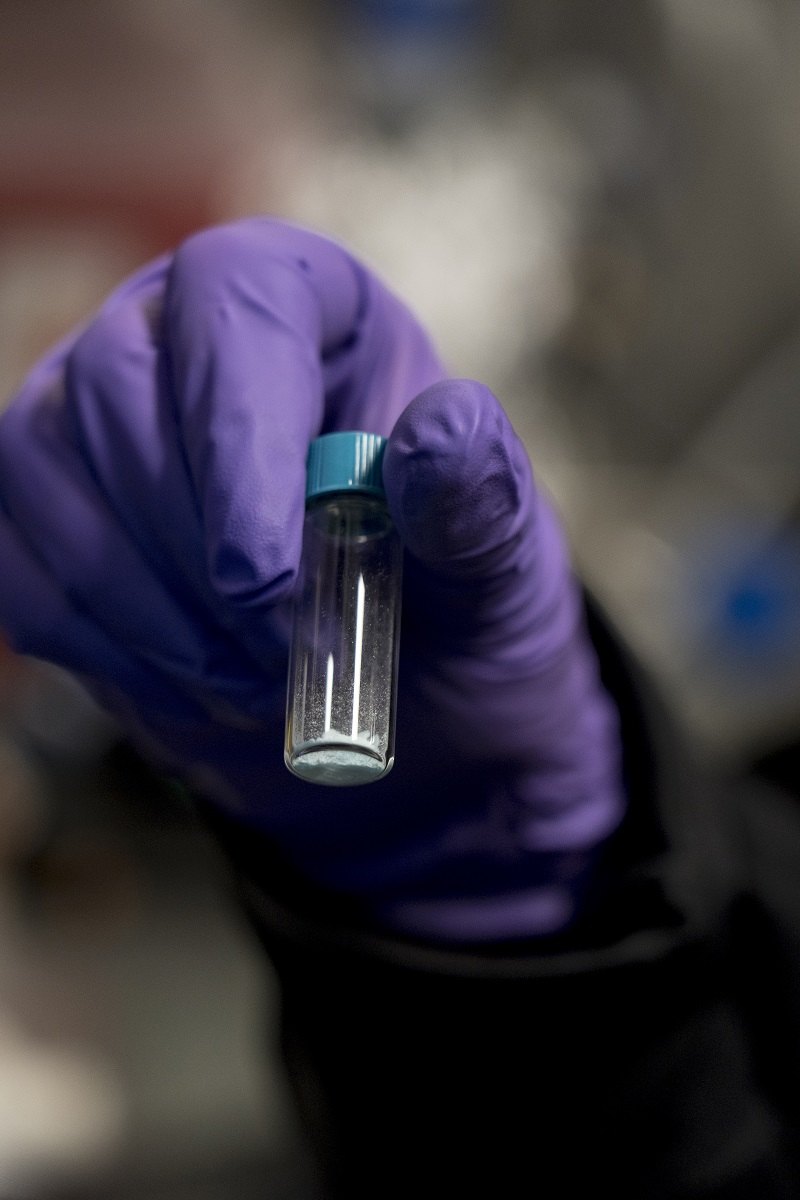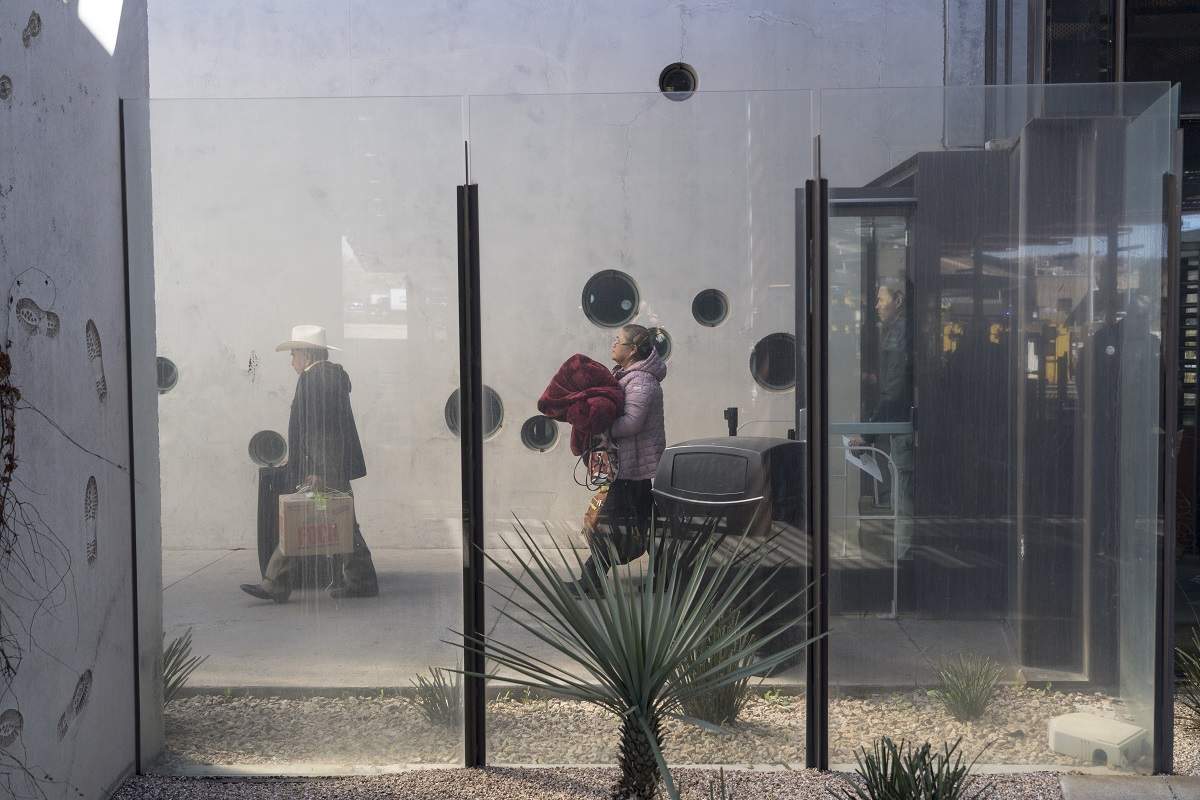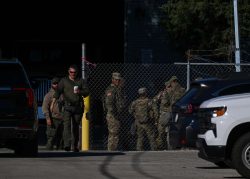
U.S. Customs and Border Protection officers conduct inspections on passenger vehicles at the Nogales-Mariposa Port of Entry in Nogales, Ariz., on Feb. 28, 2023.
14:45 JST, March 10, 2023
NOGALES, Ariz. – The trucks packed with cucumbers, green beans and bananas inched forward in a long, looping line, waiting to come into the United States at the Mariposa port of entry, one of the border’s busiest crossings for Mexican-grown produce.
U.S. inspectors used to refer only a handful of drivers for cargo screening with powerful scanning equipment to check for illegal drugs.
But on a recent morning they routed every truck through a new drive-through machine the size of a carwash. Known as a “multi-energy portal,” the equipment has allowed U.S. Customs and Border Protection to scan nearly six times as much cargo per day.
Construction crews were busy installing a second machine alongside it, racing to finish before peak grape season this spring, when trucks coming from Mexico are expected to roll through with 30 million pounds of fruits and vegetables per day. The harvest is an auspicious time for drug smugglers.
The Nogales crossing is the front line of the government’s beleaguered effort to stem the flow of cheap fentanyl into the United States. The synthetic opioid is fueling the most lethal drug epidemic in U.S. history, and last year, Nogales surpassed San Diego to become the southern border’s primary gateway for fentanyl trafficking.
U.S. officers have seized more than 21 million fentanyl tablets in the Nogales port of entry over the past five months, more than they did during the entire previous year, according to CBP.
Officers are finding sacks of baby-blue fentanyl pills inside seat cushions, car batteries, even hollowed-out bicycle frames. One pedestrian tried to come through in January wearing a sheaf of tablets that looked like a pair of shorts. Another smuggler jammed 14,000 pills inside the metal frame of a walker. “Fentanyl is so small that they’re hiding it in places that weren’t imaginable before,” said Michael Humphries, CBP’s Nogales port director.
Drug overdoses killed more than 107,000 people in the United States in 2021, the highest total ever, according to the most recent available tallies by the Centers for Disease Control. Two-thirds of those deaths were caused by fentanyl. The highly addictive opioid can be prescribed by physicians to treat severe pain, but illegal tablets from Mexico are flooding across the border at powerful and potentially fatal dosage levels.
Mexican drug trafficking organizations manufacture the pills in clandestine labs using chemicals primarily imported from China, mass producing tablets that retail on U.S. streets for less than $5 apiece.
Fentanyl trafficking is dominated by the two most powerful criminal organizations in Mexico, the Sinaloa cartel and the Jalisco New Generation cartel, according to the Drug Enforcement Administration.
Those groups control smuggling routes through western Mexico that lead to U.S. border crossings into Arizona and California. The two states accounted for 90 percent of all the fentanyl seized by CBP during the 2022 fiscal year, according to agency data.
President Biden’s critics blame his border policies for the fentanyl boom, attempting to link narcotics trafficking with the record numbers of migrants CBP has taken into custody during his first two years in office. CBP data show the drug is overwhelmingly smuggled through U.S. ports of entry – the official crossings – which account for more than 96 percent of fentanyl seizures along the border since the start of the 2023 fiscal year on Oct. 1.
The White House and the Department of Homeland Security have responded to the fentanyl surge by promoting the advanced scanning machines – known as “non-intrusive inspection” technology, or NII – as a centerpiece of their interdiction strategy. During his State of the Union address last month, Biden pledged to combat fentanyl “with more drug detection machines to inspect cargo and stop pills and powder at the border.”
Democrats and Republicans support the broad outlines of those plans. But enthusiasm for the scanning technology is especially pronounced among Democrats eager to push back at criticism that they’re weak on border security. Unlike physical barriers such as a wall, they see NII machines as a border tool that symbolizes openness to trade and travel as well as high-tech security.

A physical scientist working for U.S. Customs and Border Protection analyzes fentanyl at the Nogales-Mariposa Port of Entry in Nogales, Ariz., on Feb. 28, 2023.
The government has struggled to keep pace with traffickers. Congress gave CBP $564 million in 2019 for a major expansion of the NII systems, but the agency was slow to award contracts, according to current and former federal officials who monitor the programs. The Biden administration has picked up the pace of deployment, but the NII program is still roughly three years behind schedule, and the artificial intelligence software needed to manage the huge amount of data remains in development.
CBP’s recent investments in the scanning equipment have also outpaced the government’s ability to reconfigure U.S. border crossings to accommodate the large machines and reroute entry lanes through them. In some locations, the agency underestimated the costs of making the machines fit, causing further delays.
“We’re now in situation where the civil works costs are becoming astronomical, and they’re eating the program alive,” said one government employee who tracks the issue closely but was not authorized to speak publicly.
The 2024 White House budget released Thursday includes $305 million for NII upgrades at CBP’s ports of entry “with a primary focus on fentanyl detection.” The increase is part of a Biden plan to install 123 “new large-scale scanners” by 2026. The administration’s goal is to raise the number of multi-energy portals used to screen cross-border trucks from four – including the one already operating in Nogales – to 35, according to DHS. The plan would boost the number of “low-energy portals” for scanning passenger vehicles from seven to 88.
Most of CBP’s previous-generation truck scanners require drivers to park and exit their vehicles, then go to waiting rooms until they can be cleared for entry. The new systems allow the drivers to roll through while remaining at the wheel, because the multi-energy portal screens the truck cab with safer, low-intensity X-rays before switching to more powerful high-energy beams for the cargo area. CBP is separately deploying low-energy portals that can quickly scan passenger vehicles in secondary inspection.
The new machines will ramp up U.S. inspection capacity from around two percent of passenger vehicles and about 17 percent of cargo vehicles to 40 percent of passenger vehicles and 70 percent of cargo vehicles, according to Biden officials.
“What CBP is doing is harnessing technology to address a product of technology – a synthetic product of technology,” said Homeland Security Secretary Alejandro Mayorkas, referring to fentanyl.
“These machines are making and will continue to make an enormous difference,” Mayorkas said, in an interview. “They speak to the president’s directive to bring all resources to bear in the fight against fentanyl and to think creatively and innovatively to develop new tools.”
Congress has worked with CBP to develop separate funding streams for equipment, civil works and artificial intelligence acquisition in an attempt to make sure the three elements of the NII systems are in sync. But in the meantime, at busy crossings like Nogales, CBP officers have to manually review the images produced by the scanners. A team of six officers in a new command post here scrutinized the vehicles’ cargo, hunting for suspicious densities or shapes that could be narcotics.
Current and former officials who work with the systems say the companies that design the artificial intelligence software need access to a large volume of vehicle images to develop the algorithms that could automatically detect such “anomalies,” as CBP calls them. But the privacy concerns of companies moving goods across the border have put limits on information sharing between CBP and the companies developing NII systems, hampering their development.
“This is ultimately a problem of data. You need to have real-world operational data shared with industry so they can test their algorithms,” said the government employee who tracks the issue and estimates the artificial intelligence software won’t be ready for two to three more years.
The government’s physical infrastructure at the ports of entry is also a problem. Most of the land and buildings is owned by the General Services Administration, not CBP, and the border officials say they are often frustrated that they cannot make repairs or alterations to the sites. Lawmakers from both parties said they want CBP to have more control of the ports of entry.
Sen. James Lankford (R-Okla.), who has followed the issue closely as a member of the Senate Homeland Security and Governmental Affairs Committee, said he’s been “pretty frustrated with GSA,” citing agency repair costs that are “extremely expensive even for small projects” such as fixing plumbing.
“CBP just needs more ability to be able to control their own facilities and to be able to make their own decisions,” said Lankford, who has introduced a bill with Sen. Kyrsten Sinema (I-Ariz.) to give CBP the authority to spend up to $300,000 for repairs and minor alterations at the ports of entry.
Nathan Osburn, a spokesman for GSA, said in a statement his agency supports CBP’s efforts to add more scanning equipment, and “to make related facility alterations to accommodate those technologies.”
CBP faces other challenges to meeting the 2026 scanning targets laid out by lawmakers and the Biden administration. To screen the majority of cars and trucks, the agency will probably need to place the machines in an area of the entry lanes before officers’ inspection booths, known as “pre-primary,” to avoid creating bottlenecks. But many of the California and Arizona border crossings don’t have space for that, because the inspection booths are located too close to the international boundary line.
That means the agency will either need to move the officer booths north, or negotiate an agreement with Mexico to be able to place the new U.S. scanning machines south of the border.
At locations including where CBP has already installed the advanced systems, traffickers appear to be adjusting tactics. In Nogales, most fentanyl is detected in passenger vehicles or seized from pedestrians who walk across the border carrying drugs in body cavities or taped to their torsos under clothing. “We depend on our K-9s and officers to stop them,” said CBP’s Humphries.
The cartels often enlist U.S. citizens to serve as couriers. U.S. citizens constitute 86 percent of fentanyl trafficking convictions in 2021, according to the U.S. Sentencing Commission, an independent agency of the federal judiciary branch.

Pedestrians and motorists make their way through the Nogales-Mariposa Port of Entry in Nogales, Ariz., on Feb. 28, 2023.
"News Services" POPULAR ARTICLE
-

American Playwright Jeremy O. Harris Arrested in Japan on Alleged Drug Smuggling
-

Japan’s Nikkei Stock Average as JGB Yields, Yen Rise on Rate-Hike Bets
-

Japan’s Nikkei Stock Average Licks Wounds after Selloff Sparked by BOJ Hike Bets (UPDATE 1)
-

Japan’s Nikkei Stock Average Buoyed by Stable Yen; SoftBank’s Slide Caps Gains (UPDATE 1)
-

Japanese Bond Yields Zoom, Stocks Slide as Rate Hike Looms
JN ACCESS RANKING
-

Tokyo Economic Security Forum to Hold Inaugural Meeting Amid Tense Global Environment
-

Keidanren Chairman Yoshinobu Tsutsui Visits Kashiwazaki-Kariwa Nuclear Power Plant; Inspects New Emergency Safety System
-

Imports of Rare Earths from China Facing Delays, May Be Caused by Deterioration of Japan-China Relations
-

University of Tokyo Professor Discusses Japanese Economic Security in Interview Ahead of Forum
-

Japan Pulls out of Vietnam Nuclear Project, Complicating Hanoi’s Power Plans
























